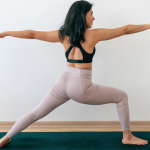How To Fill Your Yoga Class
Many people argue that the number one marketing tool, that is the best method to fill your yoga class, is word of mouth, but as a beginning teacher — fresh from your training with all your newfound knowledge of Sanskrit, muscle groups and chants — what you lack to really take advantage of word of mouth marketing is an existing bank of satisfied customers behind you.
The leg work to getting students starts the day you buy your insurance, and although it can get easier with time, the most successful young yoga teachers are taking full advantage of the marketing opportunities at their disposal. The best part? It doesn’t have to cost you an arm and a leg.
With so many yoga teachers in London, the din of people clamouring to share their next class times and locations results in nothing short of a dull roar. Amidst all the social media platforms, poster-overloaded yoga cafes and established teachers you don’t think you could ever compare to, how does anybody get noticed?
Why Are You Teaching Yoga?
From my experience as a marketer (and a consumer), I’ve found that when you do eventually get the attention of an audience you have a very short time to answer three important questions before they click the next BuzzFeed link. This time is valuable and you need your answers ready. The questions are:
1. Who Are You? — This one is reasonably simple. You need to identify yourself, be it as a yoga teacher, a person, and/or a brand.
2. What Are You Doing Here? — If you’re reading this article I assume you are here to teach yoga, but it gets more complicated than that…
3. Why Should I Care? — This is the hard part. With all the studios in London, all the classes they hold, and all the teachers running them it takes more than your 200-hour training certificate to stand out. It’s important to have a niche.
What style of yoga do you teach? Do you like to work with children? Pregnant women? Convicts? What else do you do in your life that could inform your practice? If you’re a physio you might offer a more physically aware class, or if you’re an office worker you might gear classes towards people who spend a lot of time sitting down. Once you find your Unique Selling Point (USP): something you offer that few others do, you have something to keep the attention of your students.
Now that you’ve got all that down, pull up Facebook, Instagram and Twitter to get your marketing efforts started in earnest.
See Also: #DigitalAgeYogi — Has Social Media Changed Our Practice?
Make Social Media Your Best Friend
We looked at how social media has had a lasting impact on our practice, but what about our teaching? In the last few years, one of the most important (and cheapest) ways to raise the profile for your classes is to set up your social media accounts — but there are right and wrong ways to do it…
- Pick A Name — Going back to the ‘Who Are You?’ question above. Ideally your name would incorporate some part of your USP, but many people also choose to use their name followed by ‘Yoga’.
- Fill In All The Fields — The more information you give social media, the easier it will be for people to search you. Try using key words more than once (i.e. yoga, stretch, London, etc.) and make sure you don’t leave anything blank!
- Get Some Photos — A 2014 study conducted by the good folks down at Buffer found that 63% (or two-thirds) of all social media updates are images. That isn’t to say you need to go spend a lot of money on professional photos straight away. Promise to cook dinner for a friend who’s handy with an iPhone, and go snap some photos in various poses around London! Once you do have some money to splurge I would absolutely recommend spending it on getting photos of you doing yoga or having a logo and some marketing materials made up!
- Follow People and Stay Active! — Once you set up a social media account, updating your status regularly is key. Simply put: active accounts get more followers. It doesn’t have to be complicated, every day or two jot down an observation about your practice, announce that you’re teaching a class coming up, praise the teacher whose workshop you just took or share an interesting article!
I would recommend starting with a Facebook, Instagram and Twitter profiles. The best part about these is that for the most part you can re-use the updates between your multiple profiles! Once you feel like you can handle juggling the three, you can branch out to others platforms that might be useful to you if you wish. If you know you want to teach in a lot of corporate settings, maybe LinkedIn would be a good place to set up. Or if you have more of a gym-bunny style practice — NomNom could be a good app to take on!
Go Easy On Paper Marketing
One of the most frequent questions I hear is, “Should I have business cards and brochures printed?”
My answer? Probably not.
I have a bag in my room from our recent trip to the OM Yoga Show that is overflowing with brochures and cards that I picked up with the best of intentions in the first place. I genuinely picked up these sheets thinking, “Yeah, I’ll look into that,” and they’ve been sitting in a pile making me feel guilty ever since.
I say this because it doesn’t encourage me to go out and spend the time and money to have brochures designed and printed. It gets lost easily, you often have to order it in bulk, and if any of the details change — all of the posters/brochures/cards become irrelevant. That being said, paper marketing has it’s place, especially once you have a bit of traction as a teacher.
If you’re hosting a workshop and there’s a studio willing to put up a poster for you, go to! Another thing a lot of teachers have that I don’t mind are business cards or small brochures that tell you how to get in touch with the teacher and their website (another great option for online marketing if you’ve got some time and/or money). MOO.com is a great website for designing business cards at a reasonable price — and they’re great to have on-hand to give out after class or if anyone asks about your teaching!
Most of All, Be Gracious
Getting started as a yoga teacher is a marathon, rather than a sprint. Be prepared for a gradual build and don’t allow yourself to be desperate for people to come to your class. People can smell that a mile away, and it’s not encouraging. On the other hand, don’t be a hard sell either. Instead, try to approach self-marketing as a yoga teacher from a place of seva, or selfless service. Let the idea that you’re here to help people underlie any interaction you have with current or potential students.
Another thing to keep in mind is that you’re not going to be everyone’s cup of tea, and that’s okay. It would be impossible to be everybody’s favourite teacher. Know what you teach, find out who wants to learn it and start to build your tribe slowly. It’s better to have five people who love your class than fifty people who could take it or leave it.
This is just one piece of marketing advice amongst many. Do you agree or disagree with what I’ve said? What kind of marketing tactics have worked for you as a teacher? Anything you wish to add? Let us know in the comments below.













